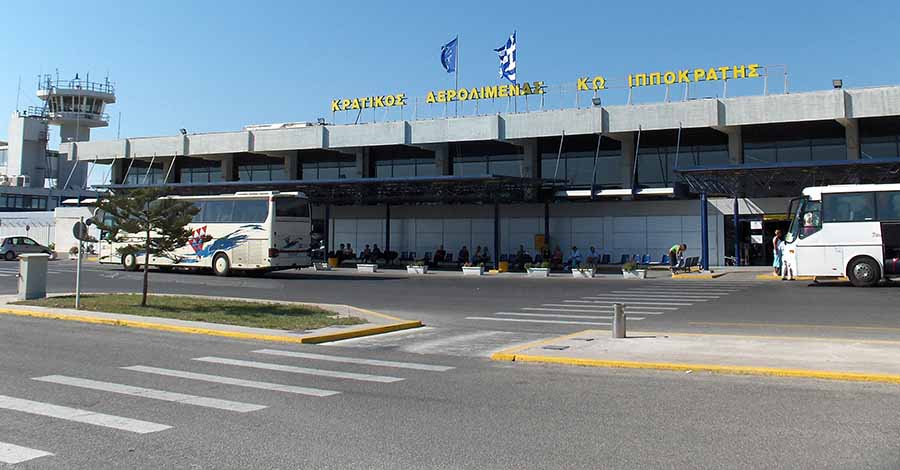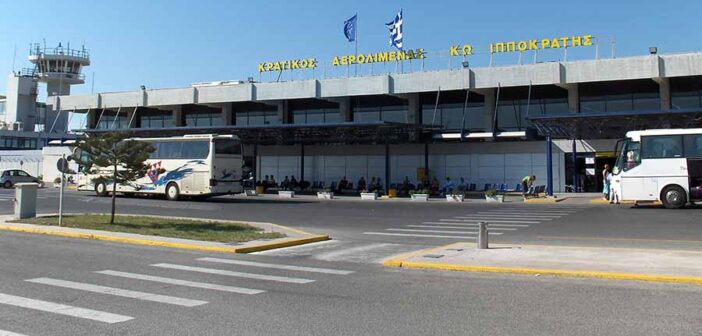
Kos International Airport (KGS), located near Antimachia village, 23 kilometres from Kos Town, serves as a key gateway to the Greek island of Kos, handling nearly 3 million passengers annually. The single terminal, expanded in 2021 to 24,000 square metres, offers a modern and straightforward layout with 28 check-in desks, clear English signage, and separate Schengen and non-Schengen zones for efficient navigation.
Arrivals and departures are housed on the same level, with short walking distances to gates, though the absence of air bridges means passengers board via mobile stairs. For those with mobility needs, wheelchair assistance, accessible toilets, and lifts are available, with support provided if requested 48 hours in advance through airlines or the airport’s information desk.
Access to the airport is convenient, with multiple transport options connecting to Kos Town and nearby areas like Mastichari, Kardamena, and Kefalos. KTEL buses operate regular routes to these destinations, with a 35-minute trip toKos Town costing around €3.20, purchasable onboard.
Taxis, stationed outside the terminal, cost approximately €50 (£42) to Kos Town, with pre-booked transfers available for added convenience. Car rental agencies, including Avis, Hertz, and Sixt, are located in the arrivals area, and the airport is accessible via the main road from Antimachia, with 500 parking spaces, including short-term options near the terminal. A drop-off zone allows brief stops at no cost, though parking can fill quickly during peak summer months.
The passenger experience is designed for efficiency, but high tourist traffic from May to October can create challenges. Check-in opens three hours before international flights and two hours before domestic, closing 40 minutes prior, with self-service kiosks available for airlines like Aegean.
Security screening, with multiple lanes, averages 10 to 20 minutes but can extend to an hour during peak summer periods due to increased passenger volumes. Travellers should arrive three hours early for international flights to account for potential queues. Free Wi-Fi is accessible via the “AdP_FreeWifi” network with social media login, and charging ports are available near seating areas. The Business Lounge, open to all for around £25, offers snacks, drinks, and workspaces, while a first aid station, baby-changing facilities, and a lost and found desk at the information counter add practical support.
Dining and retail options are modest but cater to traveller needs. The terminal features a café, snack bars, and a restaurant serving local and international dishes, with a coffee priced at €3 and meals around €10–€15. Duty-free shops offer perfumes, alcohol, and Greek souvenirs, while a newsstand and small gift shop provide snacks and travel essentials, open from 5 am. until the last flight. A currency exchange desk and ATMs are available in the arrivals hall, though some passengers note limited dining choices and high prices during peak hours.
On-time performance is generally reliable, with most flights departing within 15 minutes of schedule, supported by a 2,400-metre runway and modern navigation systems. However, summer congestion and occasional weather issues, such as strong winds, can cause delays. Passengers should monitor flight statuses via the airport’s app or digital boards. For connections, the single terminal simplifies transfers, with minimum connection times of 40 minutes for domestic and 60 minutes for international flights, often through Athens or major European hubs like London or Frankfurt. Fast-track security, available for purchase, reduces wait times for tight connections.Potential delays often stem from high passenger volumes during peak season, leading to crowded check-in and security areas. Some travellers report insufficient seating and long queues at immigration, particularly for non-Schengen flights, with waits of up to two hours. Road traffic to the airport can also slow during summer, so extra travel time is advised.
Aer Lingus
Aer Lingus check-in is in the main terminal, departures hall (dynamic desks 1-20; assignments vary due to the airport’s small size, self-service kiosks available). Check-in opens 2 hours before departure and closes 45 minutes before departure. Online check-in is available 30 hours to 4.5 hours prior. Departures are most commonly from gates 1-12 (non-Schengen area; dynamic, shown on screens ~30-45 minutes before departure).
Ryanair
Ryanair operates flights to Dublin on Tuesdays and Saturdays. Ryanair check-in is in the main terminal, desks 1-20 (dynamic; self-service kiosks available). Bag drop opens 2 hours prior. Departures are most commonly from gates 1-12 (non-Schengen; dynamic, announced ~30-40 minutes before departure).




